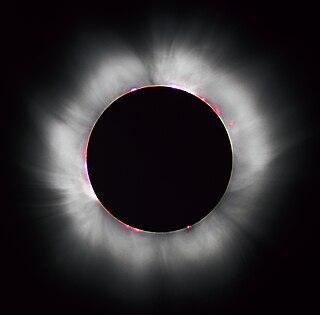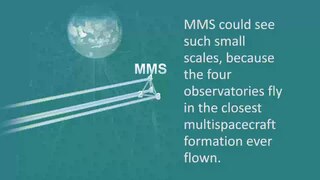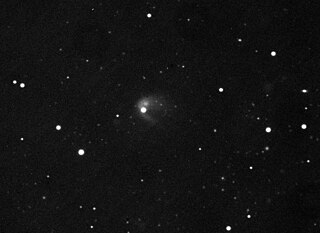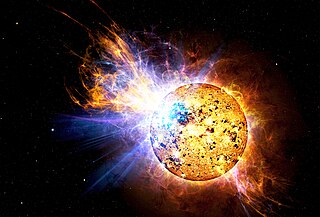Related Research Articles

A corona is the outermost layer of a star's atmosphere. It consists of plasma.

A solar flare is an intense localized eruption of electromagnetic radiation in the Sun's atmosphere. Flares occur in active regions and are often, but not always, accompanied by coronal mass ejections, solar particle events, and other solar phenomena. The occurrence of solar flares varies with the 11-year solar cycle.

A proplyd, short for ionized protoplanetary disk, is an externally illuminated photoevaporating protoplanetary disk around a young star. Nearly 180 proplyds have been discovered in the Orion Nebula. Images of proplyds in other star-forming regions are rare, while Orion is the only region with a large known sample due to its relative proximity to Earth.

A coronal mass ejection (CME) is a significant ejection of magnetic field and accompanying plasma mass from the Sun's corona into the heliosphere. CMEs are often associated with solar flares and other forms of solar activity, but a broadly accepted theoretical understanding of these relationships has not been established.

In plasma physics, an Alfvén wave, named after Hannes Alfvén, is a type of plasma wave in which ions oscillate in response to a restoring force provided by an effective tension on the magnetic field lines.

A prominence, sometimes referred to as a filament, is a large plasma and magnetic field structure extending outward from the Sun's surface, often in a loop shape. Prominences are anchored to the Sun's surface in the photosphere, and extend outwards into the solar corona. While the corona consists of extremely hot plasma, prominences contain much cooler plasma, similar in composition to that of the chromosphere.
The Milky Way has several smaller galaxies gravitationally bound to it, as part of the Milky Way subgroup, which is part of the local galaxy cluster, the Local Group.

A sub-brown dwarf or planetary-mass brown dwarf is an astronomical object that formed in the same manner as stars and brown dwarfs but that has a planetary mass, therefore by definition below the limiting mass for thermonuclear fusion of deuterium . Some researchers call them rogue planets whereas others call them planetary-mass brown dwarfs. They are sometimes categorized as Y spectral class brown dwarfs.

Active asteroids are small Solar System bodies that have asteroid-like orbits but show comet-like visual characteristics. That is, they show a coma, tail, or other visual evidence of mass-loss, but their orbits remain within Jupiter's orbit. These bodies were originally designated main-belt comets (MBCs) in 2006 by astronomers David Jewitt and Henry Hsieh, but this name implies they are necessarily icy in composition like a comet and that they only exist within the main-belt, whereas the growing population of active asteroids shows that this is not always the case.

EV Lacertae is a faint red dwarf star 16.5 light years away in the constellation Lacerta. It is the nearest star to the Sun in that region of the sky, although with an apparent magnitude of 10, it is only barely visible with binoculars. EV Lacertae is spectral type M3.5 flare star that emits X-rays.

OU Andromedae is a rotationally variable star in the constellation Andromeda. Varying between magnitudes 5.87 and 5.94, it has been classified as an FK Comae Berenices variable, but the classification is still uncertain. It has a spectral classification of G1IIIe, meaning that it is a giant star that shows emission lines in its spectrum. It is also likely in its horizontal branch phase of evolution.

Helmet streamers, also known as coronal streamers, are elongated cusp-like structures in the Sun's corona which are often visible in white-light coronagraphs and during solar eclipses. They are closed magnetic loops which lie above divisions between regions of opposite magnetic polarity on the Sun's surface. The solar wind elongates these loops to pointed tips which can extend a solar radius or more into the corona.
An active region is a temporary region in the Sun's atmosphere characterized by a strong and complex magnetic field. They are often associated with sunspots and are commonly the source of violent eruptions such as coronal mass ejections and solar flares. The number and location of active regions on the solar disk at any given time is dependent on the solar cycle.

V404 Cygni is a microquasar and a binary system in the constellation of Cygnus. It contains a black hole with a mass of about 9 M☉ and an early K giant star companion with a mass slightly smaller than the Sun. The star and the black hole orbit each other every 6.47129 days at fairly close range. Due to their proximity and the intense gravity of the black hole, the companion star loses mass to an accretion disk around the black hole and ultimately to the black hole itself.

A nanoflare is a very small episodic heating event which happens in the corona, the external atmosphere of the Sun.

The thick disk is one of the structural components of about 2/3 of all disk galaxies, including the Milky Way. It was discovered first in external edge-on galaxies. Soon after, it was proposed as a distinct galactic structure in the Milky Way, different from the thin disk and the halo in the 1983 article by Gilmore & Reid. It is supposed to dominate the stellar number density between 1 and 5 kiloparsecs above the galactic plane and, in the solar neighborhood, is composed almost exclusively of older stars. Its stellar chemistry and stellar kinematics are also said to set it apart from the thin disk. Compared to the thin disk, thick disk stars typically have significantly lower levels of metals—that is, the abundance of elements other than hydrogen and helium.

Supra-arcade downflows (SADs) are sunward-traveling plasma voids that are sometimes observed in the Sun's outer atmosphere, or corona, during solar flares. In solar physics, arcade refers to a bundle of coronal loops, and the prefix supra indicates that the downflows appear above flare arcades. They were first described in 1999 using the Soft X-ray Telescope (SXT) on board the Yohkoh satellite. SADs are byproducts of the magnetic reconnection process that drives solar flares, but their precise cause remains unknown.
Solar radio emission refers to radio waves that are naturally produced by the Sun, primarily from the lower and upper layers of the atmosphere called the chromosphere and corona, respectively. The Sun produces radio emissions through four known mechanisms, each of which operates primarily by converting the energy of moving electrons into electromagnetic radiation. The four emission mechanisms are thermal bremsstrahlung (braking) emission, gyromagnetic emission, plasma emission, and electron-cyclotron maser emission. The first two are incoherent mechanisms, which means that they are the summation of radiation generated independently by many individual particles. These mechanisms are primarily responsible for the persistent "background" emissions that slowly vary as structures in the atmosphere evolve. The latter two processes are coherent mechanisms, which refers to special cases where radiation is efficiently produced at a particular set of frequencies. Coherent mechanisms can produce much larger brightness temperatures (intensities) and are primarily responsible for the intense spikes of radiation called solar radio bursts, which are byproducts of the same processes that lead to other forms of solar activity like solar flares and coronal mass ejections.

The Alfvén surface is the boundary separating a star's corona from the stellar wind defined as where the coronal plasma's Alfvén speed and the large-scale stellar wind speed are equal. It is named after Hannes Alfvén, and is also called Alfvén critical surface, Alfvén point, or Alfvén radius. Parker Solar Probe became the first spacecraft that crossed Alfvén surface of the Sun.

Gordon Dean Holman is an emeritus research astrophysicist at the National Aeronautics and Space Administration's (NASA’s) Goddard Space Flight Center in Greenbelt, Maryland. His research mostly focused on obtaining an understanding of high-energy radiation from astronomical objects. This radiation cannot be observed from Earth's surface, but is observed with instruments on satellites launched to orbits above Earth's atmosphere. It is primarily emitted by high-energy electrons interacting with ions. These electrons also emit radiation at radio frequencies which is observed from Earth's surface. Consequently, these observations from space and radio telescopes provide a view of hot gas and energetic particles in the Universe that could not otherwise be obtained. Holman has specialized in the interpretation of these observed emissions to determine the origin and evolution of this hot gas and energetic particles. He has been described as "not just a theorist, he also looks at the data".
References
- ↑ "SPD Harvey Prize Citations". spd.aas.org. Archived from the original on 2016-05-26. Retrieved 2016-06-18.
- ↑ Reeves, Katharine K.; Golub, Leon (2011). "Atmospheric Imaging Assembly Observations of Hot Flare Plasma". The Astrophysical Journal. 727 (2): L52. Bibcode:2011ApJ...727L..52R. doi: 10.1088/2041-8205/727/2/L52 . S2CID 121213510.
- ↑ Savage, Sabrina L.; et al. (2023). "The First Flight of the Marshall Grazing Incidence X-Ray Spectrometer (MaGIXS)". The Astrophysical Journal. 945 (2): 105. arXiv: 2212.00665 . Bibcode:2023ApJ...945..105S. doi: 10.3847/1538-4357/acbb58 . S2CID 126230776.
- ↑ Winebarger, A. R.; De Pontieu, B.; Cheung, C. M. M.; Martinez-Sykora, J.; Hansteen, V. H.; Testa, P.; Golub, L.; Savage, S. L.; Samra, J.; Reeves, K. (2019). "Unfolding Overlappogram Data: Preparing for the COOL-AID instrument on Hi-C FLARE". AGU Fall Meeting Abstracts. 2019. Bibcode:2019AGUFMSH33A..06W.
- ↑ "Reeves, Katharine". Smithsonian Institution. Retrieved 24 October 2019.
- ↑ "Kathy Reeves Awarded the 2016 Karen Harvey Prize for Solar Astronomy". www.cfa.harvard.edu/. 2015-12-17. Retrieved 2016-06-18.